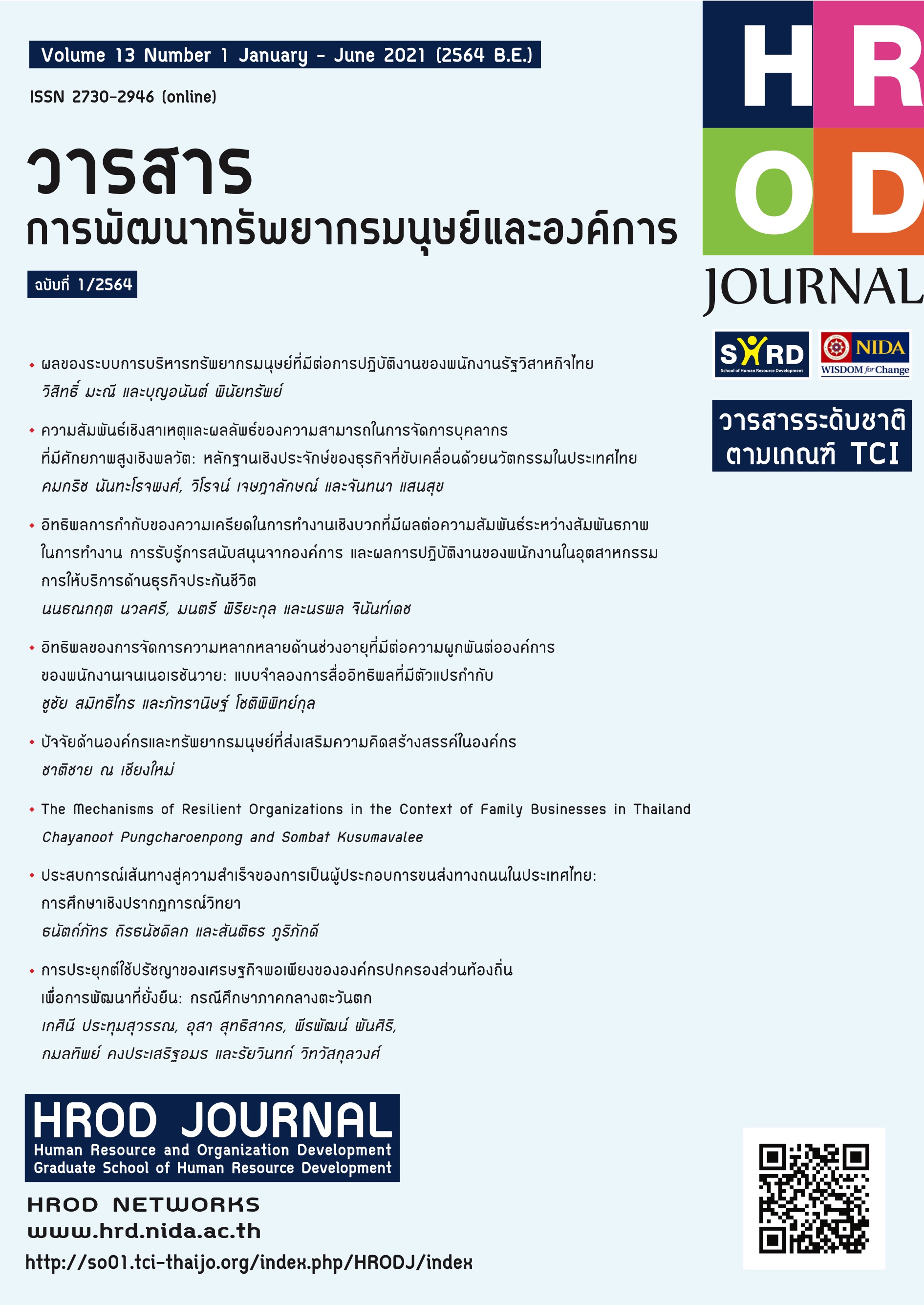Organizational and Human Resource Factors Fostering Creativity in Organizations
Main Article Content
Abstract
This research aims to find out to what extent a set of organizational and human resource factors has contributed to creativity in an organization. There are two groups of studied factors. The structural factors are organizational structure, work process, communication and HROD platform. The psycho-cultural factors include personal mastery, leadership style, global literacy and contextual judgment. A mixed method of qualitative and quantitative analysis was used to identify key factors that enable creativity capability of 141 business organizations in Bangkok and vicinity. The effect of these factors was compared between organizations that received national innovation awards and member organizations of the Federation of Thai Industries and Thai Financial Institutions.
It was found that the structural factors had no different effects from those of psycho-cultural factors in contribution to organization’s capability in creativity. And there was no single overriding factor that contributes significantly to foster an organization’s ability to be more creative. And these two clusters of factors do not bring about differences in creative capability between the awarded innovative organizations and organizations in general. The eight studied factors have had altogether a compound effect on an organization’s innovative capability. Among the structural factors, communication factor has had strongest effect on the psycho-cultural factors in both innovative organizations and organizations in general. While the work process had a significant effect on development of creativity ability in the innovation awarded organizations, the HROD platform had more effect in business organizations in general.
Article Details
1) The content of article in HROD journal is the author’s wholly responsibility to research, analyze, summarize, compile, and reference data. The editorial department will not be responsible in anyway.
2) The submitted articles in HROD journal must be unpublished before and must not be currently under consideration for publication elsewhere. If it is detected for its repetition, the author must be responsible for infringement of copyright.
3) Authors will be asked to transfer copyright of the article to the Publisher. The article is prohibited to reproduce all or part of the text, unless allowed.
References
Aghina, W., Smet, A. D., Lackey, G., Lurie, M., & Murarka, M. (2018). The five trademarks of agile organizations. McKinsey and Company.
Ahmed, A., & Khan, T. Z. A. (2017). Phronesis embedded leadership and its role in conflict management. Organization Theory Review, 1(1), 11-22.
Awang, H., & Ramly, I. (2008). Creative thinking skill approach through problem-based learning: Pedagogy and practice in the engineering classroom. World Academy of Science, Engineering and Technology, International Journal of Social, Behavioral, Educational, Economic, Business and Industrial Engineering, 2(4), 334-339.
Bui, H. T., Ituma, A., & Antonacopoulou, E. (2013). Antecedents and outcomes of personal mastery: Cross-country evidence in higher education. The International Journal of Human Resource Management, 24(1), 167-194.
Chen, C. J., Huang, J. W., & Hsiao, Y. C. (2010). Knowledge management and innovativeness: The role of organizational climate and structure. International Journal of Manpower, 31(8), 848-870.
Choi, M., & Ruona, W. E. (2011). Individual readiness for organizational change and its implications for human resource and organization development. Human Resource Development Review, 10(1), 46-73.
Ellström, P. E. (2010). Practice-based innovation: A learning perspective. The Journal of Workplace Learning, 22(1/2), 27-40.
García-Morales, V. J., Llorens‐Montes, F. J., & Verdú‐Jover, A. J. (2006). Antecedents and consequences of organizational innovation and organizational learning in entrepreneurship. Industrial Management & Data Systems, 106(1), 21-42.
Gracht, H. A., Vennemann, C. R., & Darkow, I. L. (2010). Corporate foresight and innovation management: A portfolio-approach in evaluating organizational development. Futures, 42(4), 380-393.
Gu, M., & Tse, E. (2010). Building innovative organizations in China: The “execution+” organization. Asia Pacific Journal of Management, 27(1), 25-53.
Hamaya, S., & Oya, T. (2013). Phronetic leaders: Designing new business, organization and society. Fujitsu Science and Technology Journal, 49(4), 402-406.
Herman, A., & Palmon, R. (2011). The effect of regulatory focus on idea generation and idea evaluation. Psychology of Aesthetics, Creativity, and the Arts, 5(1), 13-20.
Hao, Q., Kasper, H., & Muehlbacher, J. (2012). How does organizational structure influence performance through learning and innovation in Austria and China. Chinese Management Studies, 6(1), 36-52.
Jafri, M. H. (2010). Organizational commitment and employee's innovative behavior: A study in retail sector. Journal of Management Research, 10(1), 62-68.
Johannessen, J. A., & Olsen, B. (2010). The future of value creation and innovations: Aspects of a theory of value creation and innovation in a global knowledge economy. International Journal of Information Management, 30(6), 502-511.
Liao, S. H., Chang, W. J., & Wu, C. C. (2010). Exploring TQM-innovation relationship in continuing education: A system architecture and propositions. Total Quality Management, 21(11), 1121-1139.
Linke, A., & Zerfass, A. (2011). Internal communication and innovation culture: Developing a change framework. Journal of Communication Management, 15(4), 332-348.
Nam, K. A., & Fry, G. W. (2010). The development of global literacy and intercultural competence as a response to the complex challenges of the 21st century: A meta-synthesis. Asian Journal of Educational Research and Synergy, 2(2), 9-32.
Park, Y. K., Song, J. H., Yoon, S. W., & Kim, J. (2014). Learning organization and innovative behavior: The mediating effect of work engagement. European Journal of Training and Development, 38(1-2), 75-94.
Quandt, C. O., & Castilho, M. F. (2017). Relationship between collaboration and
innovativeness: A case study in an innovative organization. International Journal of Innovation and Learning, 21(3), 257–273.
Rosen, R., & Digh, P. (2001). Developing globally literate leaders. Training & Development. Retrieved from http://www.thierryschool.be/solar-system/starship-II/artemis/8AbraTefadu.pdf


